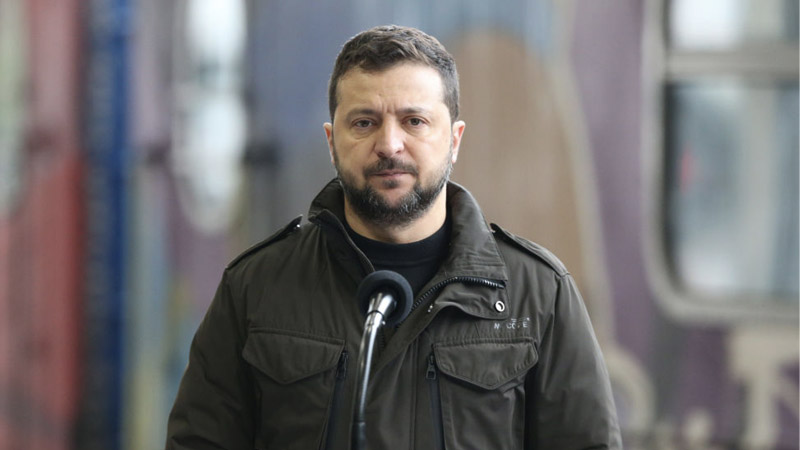Ukraine’s top commander admitted there will be no breakthrough and the battlefield situation is in a stalemate against Russia.
With the world’s attention squarely fixed on the Israel-Gaza war — while baseless hope for a Ukrainian expulsion of the Russian army has evaporated — US and European officials have started quietly conferring with Ukraine on potential concessions that could bring the war to an end, NBC News was first to report Friday evening.
These discussions aren’t about a new counteroffensive — they’re about what concessions Ukraine could live with pursuant to a peace agreement. Some of the conversations, which officials describe as delicate, happened during an October meeting of the Ukraine Defense Contact Group, an affiliation of more than 50 governments siding with Ukraine.
In eyebrow-raising comments to the The Economist this week, Ukraine’s top commander admitted there will be no breakthrough and the battlefield situation is in a stalemate. The New York Times characterized his remarks as “the first time a top Ukrainian commander said the fighting had reached an impasse.”
In September, the Times itself splashed cold water on anyone who still believed Ukraine had any hope of pushing the Russian army out of eastern and southeastern Ukraine, much less Crimea. Its detailed analysis found that, in the wake of a Ukrainian counteroffensive, “Russia now controls nearly 200 square miles more territory in Ukraine compared with the start of the year.”
Russia’s territorial gains are close to matching the goals President Vladimir Putin outlined at the start of what he calls a “special military operation.” He said Russia sought to secure Ukraine’s Donetsk and Luhansk oblasts (provinces), which he recognized as republics shortly before the invasion. Russian forces now control nearly all of those areas, which are together called the Donbas.
Russia also controls most of the Zaporizhzhia and Kherson oblasts, giving Russia a land bridge to the Crimean Peninsula, which Russia annexed in 2014 after a Western-aided overthrow of a democratically elected president and the installation of an anti-Russia government in Kiev. Crimea and the eastern provinces of Ukraine have heavily ethnic-Russian populations.
The front lines have moved little in recent months. In anticipation of Ukraine’s highly-hyped 2023 counteroffensive, Russia was content to install formidable defensive fortifications and allow the Ukrainian army to degrade itself and achieve nothing.
In its match-up with a far larger country, Ukraine’s ability to refresh its military ranks is vanishing fast. “Manpower is at the top of the administration’s concerns right now,” an official told NBC. The West can keep sending them weapons, “but if they don’t have competent forces to use them it doesn’t do a lot of good.” Even the most optimistic western warmongers must acknowledge the coming winter guarantees Ukraine won’t accomplish anything for months.
In the wake of Ukraine’s costly and futile counteroffensive, Washington’s proxy war with Russia is facing strong headwinds at home:
The war between Hamas and Israel has diverted public attention and sapped the war state’s ability to propagandize voters. Indeed, Biden’s Oval Office address appealing for aid for Ukraine and Israel was originally planned to focus solely on Ukraine, NBC reports. The US public’s pro-Ukraine fervor has cooled: A new Gallup poll found 41% say the US is doing too much for Ukraine — a big leap from the 29% who said that in June. Many Americans think that money should be used to improve conditions at home. A growing number of congressional Republicans have put away their rubber stamp for Ukraine aid, and have thus far thwarted Biden’s request for $61 billion in additional funding for the war. Biden’s ploy of a joint funding request that combines controversial Ukraine aid with Israel aid is in grave jeopardy, as House Republicans demand separate votes.
Washington’s blank-check support for Israel’s destruction of Gaza is further straining an already Ukraine-sapped American arsenal. Tens of thousands of artillery shells that had been earmarked for Ukraine are being redirected to the IDF. Even before Hamas attacked Israel, an increasingly severe shortage of conventional shells for the artillery-heavy war in Ukraine led Biden to give Zelensky toxic, depleted uranium shells, stirring an international outcry.
As for what it would take for Zelensky to surrender the international spotlight and agree to peace, we’re guessing a big deposit to a Swiss bank account would do just fine. However, officials are pondering some type of Western security guarantee that stops short of NATO membership. The specter of Ukraine become a NATO member played heavily in Moscow’s motivation for invading. The war has beena crisp illustration of Richard Sakwa’s brilliant assertion that “NATO exists to manage the risks created by its existence.”
Just weeks after Russia’s 2022 invasion, Russia and Ukraine had reportedly tentatively agreed to a peace deal in which Russia would withdraw to an extent that it would still control portions of the Donbas, in exchange for Ukraine forswearing its NATO ambitions while having security deals with several states. Via a visit from then-British Prime Minister Boris Johnson, the Western war machine, eager for a proxy war, seems to have pressured Zelensky to break off the talks. Months of misery ensued, with only the military-industrial complex and Ukraine’s aid-scraping bureaucrats better off for it.


